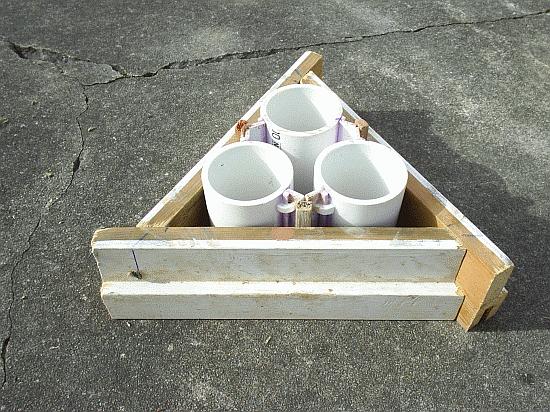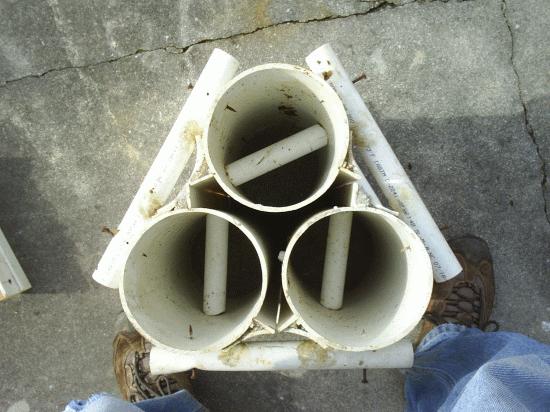E-Z Transplant Blocks
The idea for these E-Z Transplant Blocks, also called "Paradise Blocks" or "Peace Blocks", came from efforts to grow our own Fruit and Nut trees from seed. The idea being to grow our own Rootstock and do our own grafting. Nut seedlings in particular have long tap roots and are difficult to dig and transplant without root damage. Nut trees with damaged tap roots are prone to disease and rarely survive.
In the north, growing trees from seed in containers presented an additional problem. Fruit and Nut tree seeds require Stratification before they will sprout. In commercial operations this means keeping the seeds damp and refrigerated so as to mimic winter conditions in the ground. The easiest and most natural way to accomplish this is simply to plant the seeds in the fall. They then need to grow for a year or more before they can be grafted. They then must be allowed to grow for another year or more before transplanting.
Seedling tree roots grown in conventional pots or containers have no protection from cold northern winters. The roots freeze because the containers are exposed to sub-zero temperatures and bone chilling winter winds. Trees grown in pots in the north freeze to death.
A solution to all these problems was found in the honeycomb.
HONEYCOMB

If plants could be grown in honeycomb like containers, they would be completely surrounded by soil and thus the roots would be protected from cold winter temperatures much as they would if planted directly in the ground.
The only remaining problem seemed to be how to get the trees out of the containers. There are many different ways of cutting open a honeycomb cell to get it to come apart and get at the contents, but how to get it apart and then put it back together so that it can be used again and again?
Many designs were considered, but the following seemed to be the best resulting in sections that are both strong and stable and can be easily assembled and reassembled. I have been told that concrete or cement only deteriorates when allowed to dry out and that blocks of this kind filled with soil and kept moist could last for a hundred years or more.
SECTIONALIZED

Once a solution was found for growing Nut trees, It seemed that the same design would work just as well for garden vegetables, flowers, herbs and other small plants.
SMALL FORM

SMALL BLOCKS (For Plants)

LARGE FORM


LARGE BLOCKS (For Trees)

This information is provided in the hope that it will be useful for communities wishing to produce their own seedling plants and trees saving money and time, for edible landscaping or for starting a small nursery. For additional information see contact information below.
A few Notes about commercial Nursery Stock and the advantages or growing and Grafting your own Seedling Fruit and Nut Trees
I spent a great deal of hard earned money and much labor buying expensive fruit and nut trees quite often only to see them die off due to disease or transplant shock.
It was out of the desire for a self sufficient life style utilizing edible landscaping that after many years of frustration and disappointment I finally decided to learn something about the reasons for all the failures.
Most people are probably unaware that when they buy an apple tree from the local nursery outlet they are usually not buying an actual Macintosh, Red Delicious or other named variety of fruit tree growing on it's own root system, but rather a crab apple or other nondescript seedling which has been grown for a while then cut back and grafted with a tiny twig or bud from a named variety. The tiny twig or bud is then forced to grow on these foreign and sometimes incompatible roots.
When trees are cut and grafted and combined with parts from other trees, not only may there be incompatibilities but there is the chance of introducing plant viruses and other diseases through the open wounds or through the actual plant material which may be contaminated.
Something else many consumers may not be aware of is that trees grafted onto "dwarf" rootstock may also have a "dwarfed" life span. If you wish to plant a fruit tree that will be enjoyed for generations to come, grafted dwarf trees are probably not the way to go. Dwarf apple trees are produced by grafting part of a named variety onto a cloned dwarf crabapple rootstock. Basically the normal apple tree is forced to survive on the nourishment supplied by this undersized root system. Unless one is aware of this the crab apple under-stock may send up a sucker from below the graft and the desired variety grafted onto it may die off. Unless these suckers originating below the graft are removed and the graft forced to grow the tree purchased for the purpose of growing Red Delicious or some other named variety may, after many years produce only crab apples.
Further, such rootstock may be of some unknown seedling variety that is neither compatible nor well adapted to the environment into which it is transplanted. Growing your own trees from seed ensures that the seedlings will be adapted to the local climate and soil conditions
It is quite easy to grow your own rootstock and graft your own trees. Apple seeds may be obtained freely from any cider mill. Over the years I have visited many cider mills and the owners have been more than happy to find someone who has a use for the left over pulp which contains thousands upon thousands of viable seeds which are otherwise discarded. Apple trees grown from seed may not produce the best possible fruit. Due to cross pollination, every seedling will produce a slightly different kind of apple, some few may be better than the parent fruit. If there is land available it can be wonderful to simply let a seedling tree grow on its own roots to see what it produces. The chances of obtaining a new marketable variety as good or better than the parent tree from which the seed came are quite small, about one in a thousand, but these odds are much better than winning the lottery. Few seedling trees will be entirely useless for their fruit but even these can be top grafted at any time.
Seedling trees grown without grafting and without transplant shock will grow faster and healthier than your average grafted tree.
Seedlings of Stone fruit, such as plums and peaches grow more true to type than apple and will often produce fine fruit without grafting.
I have made grafting strips for tyeing grafts out of old bicycle inner tubes, used a cheap utility razor as a grafting knife and old aluminum cans for metal labels. Cuttings of named varieties to be grafted onto the seedling rootstock, when this is desired, can generally be obtained free of charge from any local orchard during pruning season or very inexpensively through the mail.
Cuttings should be kept wrapped in moist paper towels in the refrigerator or other cold location until spring when they can be grafted onto the seedling rootstock.
Commercial nurseries often obtain rootstock from large suppliers of clonal rootstock. Rooted cuttings are taken from the parent plant, then transplanted and allowed to grow after which they are dug up trimmed, packaged and shipped. The trees are then grafted on a bench in a warehouse where the rootstock and another cutting from a named variety are joined together. The grafted plants are then kept relatively warm so as to force growth and healing of the graft wounds out of season. The trees are then replanted, allowed to grow to marketable size, dug up again, the roots pruned so as to fit into pots and set out for sale in front of department stores.
Unfortunately, after this rather brutal treatment, such trees have a difficult time surviving if they survive at all.
It is my hope that by using these transplant blocks, communities will be able to simply fill them with soil and after eating an apple, pear, peach, plum or cherry simply drop the seeds or pits into these readied container cells where they can stratify through the winter and germinate. Since disease cannot be transfered through seeds, seedling trees grown in this manner are virtually guaranteed to be healthy and disease free. Further the concrete containers will help to protect the trees from rodent damage and allow very easy transplanting virtually eliminating transplant shock.
Not every seedling tree will produce the best fruit, but a tree that produces some previously non-existent variety and lives for 100 years or more to be enjoyed for generations, in my opinion, is more desirable than an expensive dwarf that will produce usable fruit perhaps for a few years before going into decline, if it survives at all.
I should add, that of course, not all fruit tree nurseries are large mass production operations. There are many fruit tree nurseries that put as much care into growing their trees as you might be able to do yourself, But if you have the room for it, why not grow out some seedling fruit and nut trees? Stop throwing away those pits and seeds to be burried in the land fill and start growing your own trees from seed.
>> E-Z Transplant Blocks Discussion Forum <<